The field of bio-convergence could potentially become one of the Israeli high-tech industry’s most substantial engines of growth. The Israel Innovation Authority is working in collaboration with additional entities to expand its operations in order to c competitive ecosystem to advance this field in Israel.
In recent years, global health and medicine have been undergoing a revolution driven by two main factors: first, the global health systems and bio-pharm industry crisis caused by a sharp increase in health expenditures and in the development costs of new medicines. The second factor relates to recent technological breakthroughs in the fields of engineering, biology and medicine. This revolution is fostering a new multidisciplinary industry that is based on the synergy between different technologies from the fields of biology and engineering known as “bio-convergence”.
The Innovation Authority believes that the Israeli innovation ecosystem has substantial potential to transform the country into a world leader in this developing field. The Authority is striving to create the conditions to enable the growth and success of the bio-convergence industry in Israel.
Global Health System Crisis
Global health expenditure continues to rise dramatically and is expected to reach 10 trillion dollars by 2022. The main causes behind this phenomenon are increased life expectancy that leads to an aging population alongside increased frequency of chronic disease such as cancer, heart disease and diabetes.1https://www2.deloitte.com/content/dam/Deloitte/global/Images/infographics/lifesciences-healthcare/gx-lshc-hc-outlook-2019-infographic.pdf Today, approximately 50% of the population in the US are considered chronically ill and these patients account for about 85% of the total expenditure on healthcare services.2Joseph C. Kvedar, “Digital Medicine’s March on Chronic Disease” , Nature Biotechnol 2016
Early and efficient medical intervention and diagnosis can prevent or delay most chronic diseases. The health system has therefore undergone significant change in recent years and today pays greater attention to early, efficient intervention and preventative medicine.
Technological breakthroughs and a combination of innovative genetic and digital technologies can assist in identifying and contending with the complexities inherent in chronic diseases. Furthermore, they help identify the “dormant” stage of these diseases to preempt outbreak of symptoms. Accordingly, health systems continue to make the transition from a model whereby success is measured by the number of patients being treated (Volume Based Model) to a model that measures success by the quality and efficiency of the treatment (Value Based Model) and that is also expressed by the ability to avoid medical treatments. This transition, necessary for both governments and service providers and by the patients themselves, is driving the need for technological innovation that can meet the new challenges and needs of the health system.
Western governments invest huge sums to improve and enhance health systems that burden public expenditure. A global comparison of national health expenditure as a percentage of GDP between 1975-2018 is presented in Fig. 6.1 below. The comparison between Israel, USA, UK, Canada, Switzerland and Austria reveals that health expenditure as a percentage of GDP in these countries has almost doubled, and in some cases, increased even more.
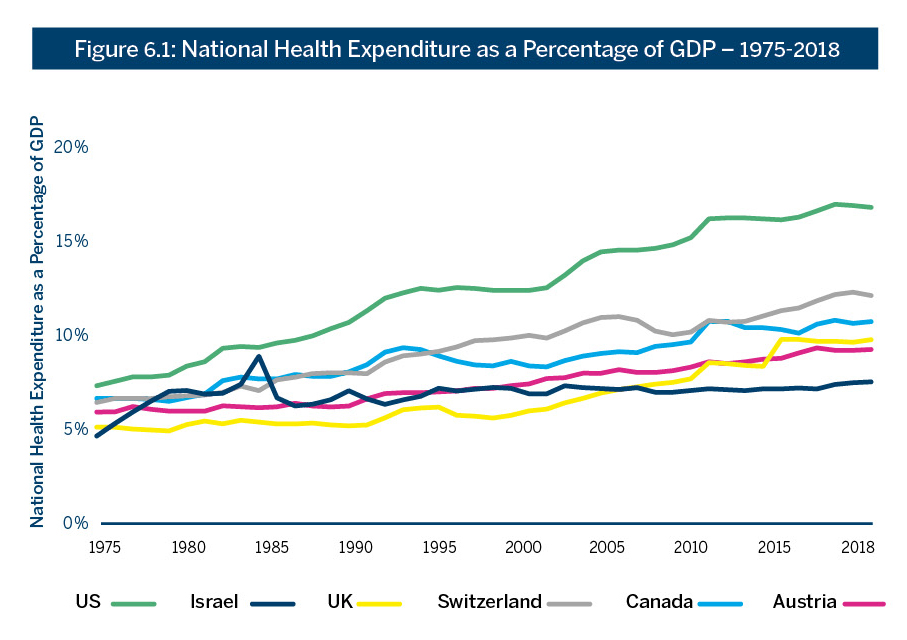
Source: OECD STAT
The Bio-Pharm Industry
The pharmaceutical industry is currently facing a major challenge. Costs of developing a new drug have increased markedly in recent years and the return on investment of drug development has nosedived accordingly. Fig. 6.2 shows how in 1970 the cost of developing a new drug stood at an average of 179 million dollars, a cost that almost doubled every decade. This reflects a 15-fold increase as by the beginning of the 21st century, the average cost of developing a new drug had reached approximately 2.6 billion dollars. The diagram also shows that despite the rising costs, there was no significant growth in the number of drugs authorized, which generally remained constant at a few dozen each year.
As a result, the return on the development cost of a new drug has declined dramatically. According to a Deloitte report that examined 12 large public corporations, the return on development cost in 2010 stood at approx. 10% while in 2018, this figure dropped to about 2%.3Deloitte UK Measuring Return on Pharma Innovation Report, 2018
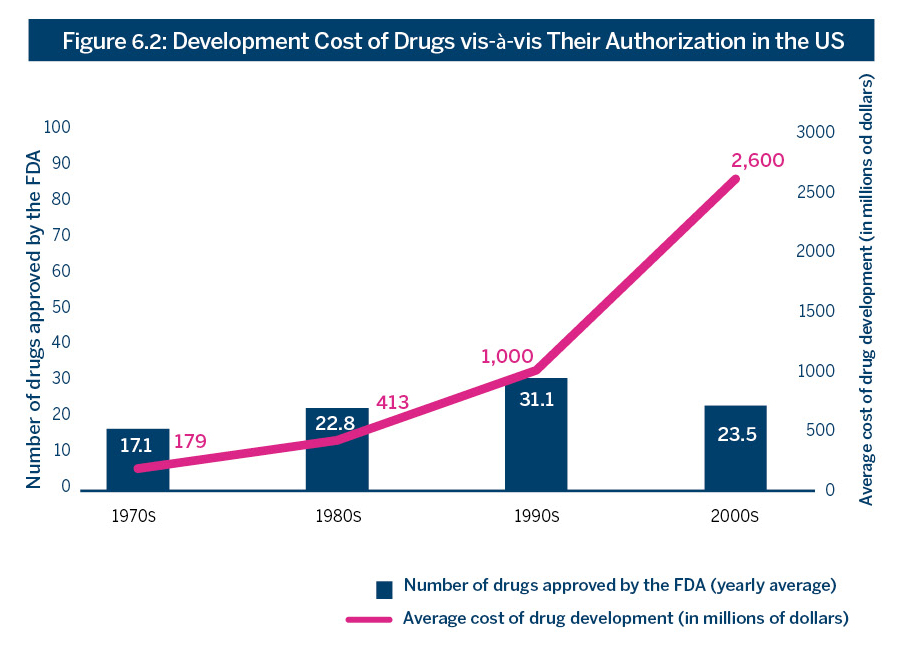
Source: An Innovation Authority adaptation of data from: Biology-inspired Micro-physiological System Approaches to Solve the Prediction Dilemma of Substance Testing
These challenges obligate health systems and the bio-pharm industry to undergo drastic changes, to identify and develop precise, personalized and effective medical solutions. The attempt to contend with these challenges has given rise to a new multidisciplinary industry known as bio-convergence that is based on connecting various technologies from the fields of biology and engineering. This industry is expected to form the future base of medicine and to reshape the global health industry.4Convergence-The-Future-of-Health-2016-Report, Cambridge, Massachusetts 2016
The Bio-Convergence Revolution
Technological breakthroughs achieved in recent years enable to connect and combine fields in a way that was previously impossible. The genomic revolution, the dramatic decline in the cost and increased speed of DNA sequencing alongside Artificial Intelligence and Big Data are today leading to the development of advanced diagnostic technologies that are based on protein-level, genomic and clinical data.
Fig. 6.3 presents the multidisciplinary technological breakthroughs that have occurred over recent decades in the fields of engineering and software alongside those in biotechnology. The combination of these fields creates bio-convergence.
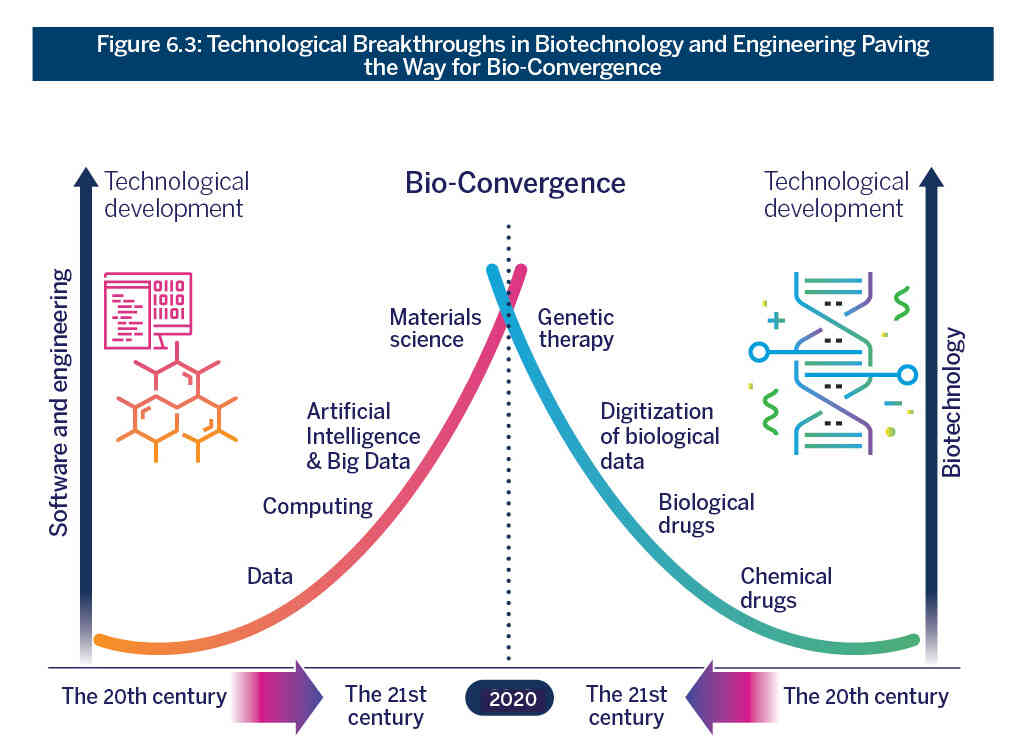
Two of the other fields developing alongside biotechnology are that of gene therapy, which is at the cutting edge of personalized healthcare, and synthetic biology that is based on the a combination of innovative technologies such as DNA sequencing, creation and writing of new genes, among others by using CRISPR technology,5CRISPR technology enables to cut out a section of damaged DNA and replace it with a sound section. behavioral modeling of specific genes, and precise measurement of gene behavior.
Apart from engineering, the Innovation Authority is witness to other multidisciplinary combinations that are based on engineering technological breakthroughs. These technologies include for example, miniaturization of electronic components combined with tissues and engineered “living” materials, smart biosensors, communications, and 3D printing of tissues. All these constitute the foundation of the technological innovation engine termed bio-convergence.
The 2018-2019 Innovation Report 6https://innovationisrael.org.il/digital-reports/ included a chapter on personalized healthcare and its potential. The bio-convergence revolution is the next stage of this trend and enables personalized healthcare, not only on the patient level but also on the molecular level so that treatments will be adapted to the disease type down to the level of the individual cell.
For example, an individual personalized treatment will be based not only on diagnostic tests but also on a combination of miniature biological sensors that continuously monitor viruses, bacteria and cancerous cells etc. The results of these tests will allow early detection of disease and administration of preventative treatment. Furthermore, smart nano-robots will allow precise delivery of treatment to damaged cells without harming heathy cells.7Torreya: The Future of the Global Pharmaceutical Industry, 2017
Fig. 6.4 presents examples of multidisciplinary technologies in the bio-convergence field:
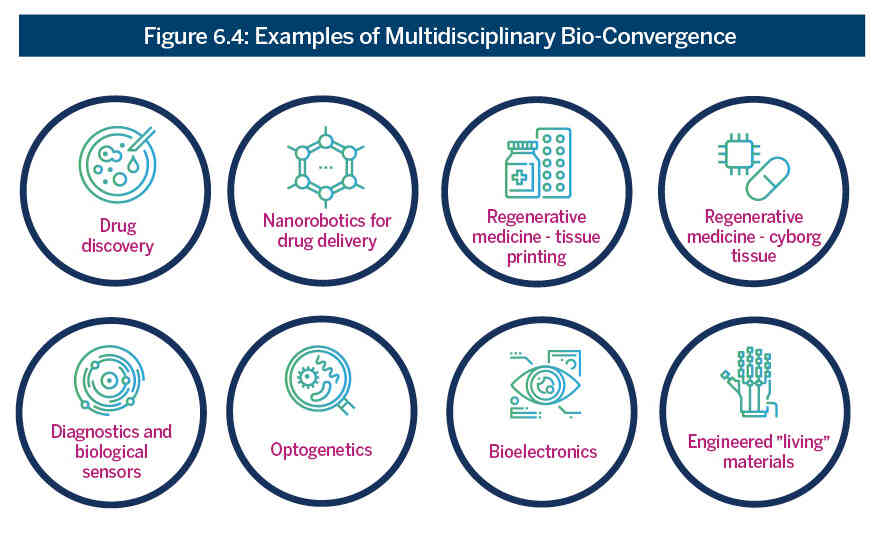
- Nanorobotics for drug delivery: One of the main challenges in the pharmaceuticals field today is the need for more efficient and precise delivery of drugs to the diseased area and specific cells. Nano-robots engineered from biological systems (such as DNA, cells or bacteria) for drug delivery to target cells are delivery systems that can store in them other drugs and materials, react to the external surroundings to identify the signal for unloading the drug, and release it in a controlled manner and at the appropriate time and location.
- Therapeutics Discovery: The need for innovative research models that will enable precise forecasting of disease development among patients has become necessary in order to improve treatment precision and efficiency. Furthermore, innovative engineering solutions enable to streamline, accelerate and even lower the costs of development of new drugs and to assist the quick and precise furthering of personalized healthcare. For example, the “organ-on-a-chip” technology enables to grow human tissue with the function of a specific organ (kidney – filter, heart – pump etc.) in a separate environment (a plastic chip for example). A new drug can be tested on this organ, thereby accelerating and lowering the costs of testing new drugs.
These innovative micro-physiological systems that combine profound knowledge of biology, biopharma and advanced engineering technologies enable the testing of new drugs. From their preliminary stages, the tests are adapted to human tissue to better simulate the progress of the disease’s development in humans. This process markedly improves the ability to identify efficient drugs and to significantly reduce the use of lab animals, an ability that is important as most drugs that successfully pass the animal testing stage fail when tested on humans.8“Why most animal models are bound to fail”, Pandora Pound and Merel Ritskes‑Hoitinga,9https://wyss.harvard.edu/technology/human-organs-on-chips/ - Regenerative Medicine: In the bio-convergence era, innovative tissue engineering technologies will change the treatment of damaged organs. This field will be based on innovative 3D Tissues Bio Printing technologies that allow to “build” new organs at individual cell resolution using new nanomaterials. This field also combines the production of “smart” hybrid implants, made of biological materials and electronic components (cyborg tissue) that integrate into the tissues. These technologies will, in the not so distant future, enable us to replace damaged organs and tissues with new tissues that possess enhanced qualities. This is yet another field in which Israel is a center of cutting-edge research and a base for pioneering companies.
- Biological Sensors and Diagnostics: One of the major healthcare challenges of the 21st century is to reduce the use of antibiotics in order to limit the evolution of bacteria that are resistant to antibiotics. This requires improved capability to distinguish between a bacterial and a viral infection. Biological sensing is a new and developing technology that combines biotechnology and nanotechnology. The biological sensing uses biological molecules such as antibodies, enzymes and nucleic acids, and bacteria to discover and identify specific materials. The biosensors are genetically engineered biological molecules which constitute a fusion between a sensor and the reporting system. This technology enables the creation of identifying components for almost any material and its advanced development towards faster and more sensitive, specific, and efficient sensors.
- Optogenetics: An innovative technology that combines genetic engineering and technologies from the world of physics such as high-speed and precise pulses of light and the use of optic fibers. Optogenetics aims to precisely activate specific neurons in the brain using light.
- Engineered “Living” Materials: Engineered materials made up of living cells that create or comprise the material itself or regulate its functional performance. For example, it is possible to create “living” materials (for medical devices and other needs) that possess the characteristics of biological systems: replication, self-healing and regulation, response to the surroundings and self-sustainability.
- Bioelectronics: A field of multidisciplinary research that combines elements of chemistry, biology, physics, nanotechnology and materials science. This field leverages new technological capabilities that allow to combine biomolecules with electronics in order to develop a wide range of functional devices.
Global Development of Bio-Convergence
Multidisciplinary academic research combining engineering with biology has existed for many years, both in Israel and around the world. Recent years have witnessed an acceleration in this field reflected by the establishment of research institutions and new models in various centers worldwide. Some American examples of this phenomenon are the WYSS Institute at Harvard University,10https://wyss.harvard.edu the KOCH Institute at MIT,11https://ki.mit.edu the BIO-X12https://biox.stanford.edu and Bio-Design programs initiated at Stanford University,13http://biodesign.stanford.edu and the Weill Neurohub Institutein San Francisco.14https://www.ucsf.edu/news/2019/11/415906/weill-neurohub-will-unite-ucsf-uc-berkeley-u-washington-find – new-treatments These institutes combine biology researchers from different fields and scholars from the fields of mathematics, physics, computer science, and engineering with the aim of accelerating the development of innovative treatments.
Other countries outside the US are also investing significant resources to advance multidisciplinary research in this field. For example, institutes such as KIST,15https://bsi.kist.re.kr/our-research/biomicrosystems/ and KAIST16https://kis.kaist.ac.kr/ in South Korea, that combine brain science, materials, and life sciences with institutes in the fields of nanorobotics, nanoelectronics, and diagnostics. The British CRUK Institute for cancer research is another example of a recently established multidisciplinary academic model.17https://www.icr.ac.uk/our-research/centres-and-collaborations/strategic-collaborations/convergence-science-centre
Bio-convergence is still in its industrial infancy however the large pharmaceutical companies have recently identified its potential. These companies are starting to search for innovative solutions that combine engineering and biopharma by establishing collaborations with different technology companies. For example, in 2016, the giant British pharmaceutical company GSK and the Google subsidiary Verily invested 715 million dollars in the foundation of a joint initiative in the field of bioelectronics aimed at developing treatment for chronic diseases.18https://www.fiercebiotech.com/medical-devices/gsk-and-google-s-verily-create-715m-joint-venture-bioelectronicsThis joint initiative, called Galvani Bioelectronics, focuses on development and commercial application of medical treatments that are based on electric nerve stimulus.
The Setpoint Medical corporation19https://setpointmedical.com/ is another pioneer in the use of bioelectronics to treat neurological diseases and is based on a combination of immunology, brain science, and electronic engineering. Several companies are leading the field of synthetic biology in the US, including Zymergen and Ginkgo Bioworks.20https://cen.acs.org/articles/94/i45/Ginkgo-Bioworks-Zymergen-scale-synthetic.html
Israeli Leadership in the Field of Bio-Convergence
Bio-convergence requires a multidisciplinary knowledge base that combines research and development capabilities alongside leadership in the fields of engineering, life sciences, and medical devices. An Innovation Authority examination revealed that the Israeli innovation ecosystem is well placed to assume a leading role in this field. Figure 6.5 presents the main strengths of the Israeli innovation ecosystem, which places Israel in an excellent starting position to become a world leader in this field.

- Israel is a leading center of research in the field of life sciences and exact sciences and is ranked fourth in a global index measuring the average number of quotations per articles published in multidisciplinary research.21https://www.scimagojr.com/countryrank.php?order=cd&ord=desc&min=600&min_type=it&area=1000 Israel is ranked in the top five countries for the number of patents per capita,22https://www.luzzatto.co.il/images/publications/israel-national-technological-innovation-report-2016-hebrew.pdf and the Weizmann Institute of Science was ranked second in the world in the prestigious ‘100 Nature Index’.23http://www.weizmann.ac.il/WeizmannCompass/sections/briefs/weizmann-ranked-2-globally Israel is also home to world-leading clinical research centers.24https://en.globes.co.il/en/article-newsweek-ranks-israeli-hospital-in-worlds-top-ten-1001278994
- Israel has a strong medical device industry that includes more than 600 companies,25IATI Report, 2019 exports of approximately 1.6 billion dollars,26Export Institute Data, 2018 and R&D centers of the world’s leading medical devices companies (Medtronic, General Electric, Philips and others).
- Israel is a leader in the field of Artificial Intelligence (see Chapter 5 in this report), including a flourishing digital health industry of more than 500 companies, most of which are based on Artificial Intelligence.
The combination of these strengths together with proven multidisciplinary development capabilities and research makes the Israeli innovation ecosystem one of the most attractive in the world for building an innovative bio-convergence industry. There are already Israeli researchers and companies with unique cutting-edge technologies in this field. The Innovation Authority can currently identify approximately 80 innovative companies operating in the field of bio-convergence.
Examples of companies that rely on technologies in the field of bio-convergence:
- Nanorobotics for Drug Delivery: Nano-Ghost27https://drugcelltherapy.net.technion.ac.il/home/stoxosomes/ is a nanometric drug delivery system developed by Prof. Marcelle Machluf from the Technion. The system is capable of homing in on cancerous tumors and precisely delivering the treatment to the cancerous cells without harming the surrounding healthy cells.
- Therapeutics Discovery: One of the companies active in this field is Anima Biotech28https://www.lionways.com/portfolio/anima that developed a unique multidisciplinary platform for discovering new therapies combining advanced optics, Artificial Intelligence and molecular biology. There are also a range of Israeli developments in the “organ-on-a-chip” field. One such company is Tissue Dynamics, which developed a unique microfluid platform that imitates the proper physiology of human tissue such as liver, brain and engineered human tissue that enables to study the mechanism of a new therapy and identify its level of toxicity.
- Regenerative Medicine: The Precise-Bio company29https://www.precise-bio.com has developed a revolutionary technology in the field of tissue printing and engineering that enables printing at the resolution of an individual cell. The company is regarded one of the leaders in this field and is the first in the world to implant a printed cornea in a para-clinical trial and to demonstrate complete functionality of the engineered organ. The company is made up of multidisciplinary teams of engineers and biologists from different fields such as cell biology, materials science, physics, chemistry and 3D printing.
- Diagnostics: The MeMed corporation30https://www.me-med.com has developed a unique platform that is capable of precise distinctions between bacterial and viral infections. The technology combines a smart algorithm, machine learning, systems engineering and molecular biology to decipher the reaction of the immune system. MeMed’s development is based on complex technological capabilities and includes multidisciplinary teams of software, systems and data-science engineers alongside experts from the fields of molecular biology and biochemistry.
Transforming Israel into a World Bio-Convergence Leader in the Next Decade
The Innovation Authority identifies bio-convergence as possessing the potential to become one of the next significant growth engines of Israeli high-tech. This industry can advance the establishment of companies that will contribute significantly to the Israeli economy and to high productivity employment. It can also become an innovation engine to create economic growth and shape the healthcare of the future, both in Israel and around the world.
Israel has an opportunity to become a leading player in the bio-convergence industry thanks to its strong technological base and other vital fundamentals including strengths in physics, engineering, data science, leading research in life sciences and the ability to integrate all these fields.
Global pharma companies come to Israel primarily because of digital technologies and are starting to consider basing their bio-convergence development here. R&D centers specializing in multidisciplinary developments in this field have yet to be established around the world, thereby giving Israel a unique opportunity to position itself as a world leader in this field and to attract new global investment and players.
Furthermore, there is a good chance that bio-convergence companies will stay and continue their development in Israel (in contrast to classic pharma companies). This is because of their close “similarity” to medical device and high-tech companies that combine several fields, and which can build a knowledge base and infrastructures that are unique to Israel.
Alongside the high potential of this field, the bio-convergence industry, being still at the outset of its development and characterized by high regulatory, clinical and financial risks, also faces many challenges.31 The Innovation Authority has a broad range of collaborations with other entities including the Council for Higher Education, the Administration for the Development of Weapons and Technological Infrastructure, the Ministry of Health, The Ministry of Science and Technology, and Digital Israel. This cooperation, that creates a competitive ecosystem supporting the advancement of the bio-convergence field in Israel, will focus on the following areas:
- Encouraging excellence in multidisciplinary research via investment in infrastructures, grants and specially designated study programs.
- National programs for translational research and the creation of new mechanisms and models to improve applied research and commercialization in order to cultivate new companies in this field.
- Special programs to support the foundation of new multidisciplinary startup companies.
- Development of programs for training human capital highly proficient in research and development, and training of human capital to manage bio-convergence companies.
- Creation of Patient Funds – capital financing mechanisms that will enable ongoing financing in this industry’s typically lengthy stages of development. These mechanisms will allow companies to traverse the “valley of death” (from prototype to product) and achieve significant revenues.
- Encouragement and promotion of global collaborations via bilateral programs and by attracting foreign companies to invest in bio-convergence research and development in Israel.
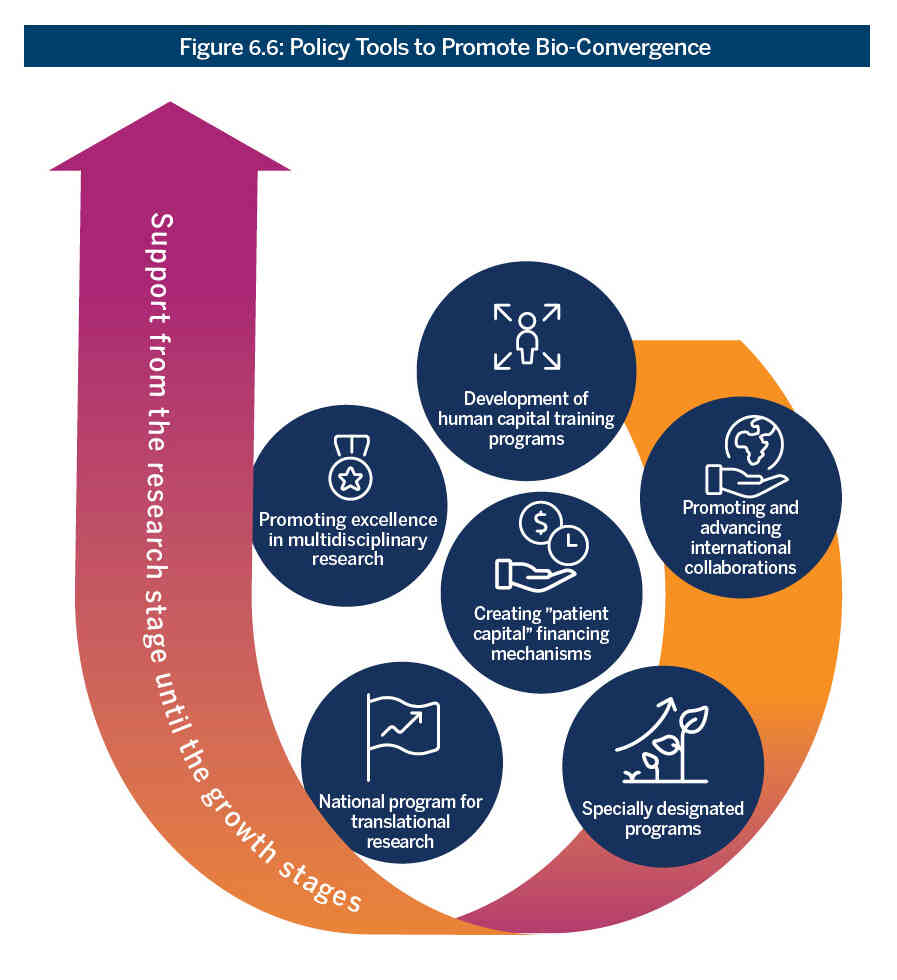
In summary, the Innovation Authority expects bio-convergence to reshape the field of medicine in the coming decade. The Authority believes that Israel’s position as a leader in research and development combined with its scientific excellence and multidisciplinary capabilities, give the Israeli innovation ecosystem the potential to transform the country into a world leader in this field. Due to the long maturation periods characteristic of the bio-convergence field, the Authority considers government support to be vital in order to create the conditions that will facilitate its future growth and success.
Academic-Industrial Breakthroughs Using Disruptive Innovation
Prof. Donald Ingber – Founding Director of the Wyss Institute for Biologically Inspired Engineering, Harvard University
